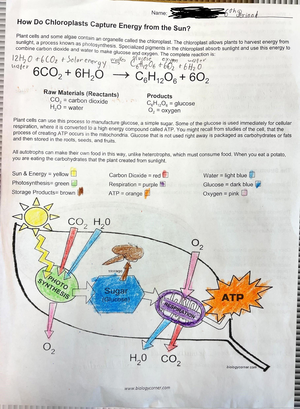





Directions: Follow the instructions to go through the simulation. Respond to the questions and prompts in the orange boxes.
Vocabulary: amino acid, anticodon, codon, gene, messenger RNA, nucleotide, ribosome, RNA, RNA polymerase, transcription, transfer RNA, translation
Prior Knowledge Questions (Do these BEFORE using the Gizmo.)
I would draw up a blueprint so the construction crew can see the plan in detail
Cells use DNA as their design plans, for it contains all the necessary genetic coding.
Gizmo Warm-up Just as a construction crew uses blueprints to build a house, a cell uses DNA as plans for building proteins. In addition to DNA, another nucleic acid, called RNA, is involved in making proteins. In the RNA and Protein Synthesis Gizmo, you will use both DNA and RNA to construct a protein out of amino acids.
Look at the SIMULATION pane. Is the displayed segment a part of a DNA or RNA molecule? How do you know?
This is part of a DNA molecule because of its double helix structure
RNA polymerase split the helix into two separate strands.
Get the Gizmo ready: ● If necessary, click Release enzyme.
Introduction: The first stage of building a protein involves a process known as transcription. In transcription, a segment of DNA serves as a template to produce a complementary strand of RNA. This complementary strand is called messenger RNA, or mRNA.
Question: What occurs during transcription?
Which RNA base bonded with the thymine? Adenine paired with thymine
A. Which RNA base bonds with adenine? Uracil and Thymine
B. Which RNA base bonds with cytosine? Guanine
C. Which RNA base bonds with guanine? Cytosine
In molecules of RNA, uracil takes the place of the DNA base
What is the nucleotide sequence of the mRNA strand you built? ATUAGCCGUAGCATCGCG USATGC
T A C G G A T A A C T A C C G G G T A T T C A A
What would be the complementary strand of mRNA?
Without start and stop codons, the ribosome wouldn’t know when the protein is complete or the strands of mRNA need to be read. Without these important codons, protein synthesis wouldn’t occur as it should, and an error can occur and cause a mutation.
Genes and traits
Get the Gizmo ready: ● You will not need to use the Gizmo for this activity.
Introduction: Inside a ribosome, amino acids are linked together to form a protein molecule. As the chain of amino acids grows, it folds and coils to form a three-dimensional shape. The complex shape that results determines the properties of the protein. Proteins have a wide variety of structures and perform many essential functions in living things.
A sequence of DNA that codes for a specific protein is called a gene. By coding for proteins, genes determine an organism’s inherited traits.
Question: How do genes code for specific proteins and traits?
Examine the codon chart below. The amino acid coded for by a specific mRNA codon can be determined by finding the first base of the codon along the left side of the table, the second base along the top of the table, and the third base along the right side of the table.
What amino acids do the following codons code for?
AUG: Methionine CUG: Leucine ACC: Threonine UAG: Stop